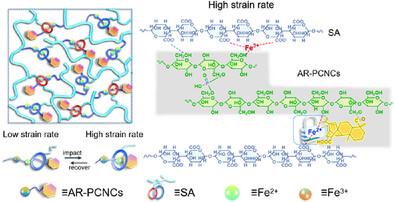Entropy–Driven Dual–Channel Dissipative Binder for Strain–Responsive Reinforcement and Stable Silicon Anodes
IF 19
1区 材料科学
Q1 CHEMISTRY, MULTIDISCIPLINARY
引用次数: 0
Abstract
Dissipative smart binders hold great potential for flexible electronics and energy storage, but achieving synergistic regulation between energy dissipation and structural reinforcement remains challenging, particularly in balancing high strength, tunable toughness, and multifunctional integration. Here, a dissipative smart binder with a dual-channel responsive mechanism is developed to enable dynamic regulation of energy dissipation and rigidity enhancement through the synergistic effects of slip relaxation and conformational locking. Centered on Fe2⁺/Fe3⁺ dynamic coordination, the binder incorporates control via the intricate and rigid rosin architecture and a hierarchy of distinct bonding mechanisms, thereby enhancing its capacity for both rapid energy dissipation and strain-triggered reinforcement. Sodium alginate serves as a continuous phase framework, reinforced by phosphorylated cellulose nanocrystals, conformation-locking segments of acrylic acid rosin, and a multivalent coordination network that enables this strain-triggered state transformation. The binder exhibits a soft-to-rigid transition with a strain-rate-sensitive hardening effect, increasing modulus up to 98 000 times and fracture energy from 104.51 to 272.34 MJ m−3. Applied in silicon anodes, it maintains 2476.5 mA h g−1 after 100 cycles at 0.2C, with ionic conductivity reaching 25.240 mS cm−1, an eightfold increase over the unmodified system. The composite network effectively mitigates structural degradation, binder fatigue, and interfacial instability caused by silicon volume expansion.

用于应变响应增强和稳定硅阳极的熵驱动双通道耗散粘合剂
耗散型智能粘结剂在柔性电子和能量存储方面具有巨大潜力,但在能量耗散和结构加固之间实现协同调节仍然具有挑战性,特别是在平衡高强度、可调韧性和多功能集成方面。本研究开发了一种具有双通道响应机制的耗散智能粘结剂,通过滑移松弛和构象锁定的协同效应,实现能量耗散和刚度增强的动态调节。以Fe2 + /Fe3 +动态协调为中心,该粘合剂通过复杂而刚性的松香结构和不同的结合机制层次进行控制,从而增强了其快速耗能和应变触发增强的能力。海藻酸钠作为一个连续的相框架,由磷酸化的纤维素纳米晶体、丙烯酸松香的构象锁定片段和多价配位网络加强,使这种菌株触发的状态转变成为可能。黏结剂表现出从软到硬的转变,具有应变率敏感的硬化效应,模量增加了98000倍,断裂能从104.51增加到272.34 MJ m−3。应用于硅阳极,在0.2C下循环100次后保持2476.5 mA h g - 1,离子电导率达到25.240 mS cm - 1,比未修饰的系统增加了8倍。复合网络有效地减轻了硅体积膨胀引起的结构退化、粘结剂疲劳和界面不稳定。
本文章由计算机程序翻译,如有差异,请以英文原文为准。
求助全文
约1分钟内获得全文
求助全文
来源期刊

Advanced Functional Materials
工程技术-材料科学:综合
CiteScore
29.50
自引率
4.20%
发文量
2086
审稿时长
2.1 months
期刊介绍:
Firmly established as a top-tier materials science journal, Advanced Functional Materials reports breakthrough research in all aspects of materials science, including nanotechnology, chemistry, physics, and biology every week.
Advanced Functional Materials is known for its rapid and fair peer review, quality content, and high impact, making it the first choice of the international materials science community.
 求助内容:
求助内容: 应助结果提醒方式:
应助结果提醒方式:


